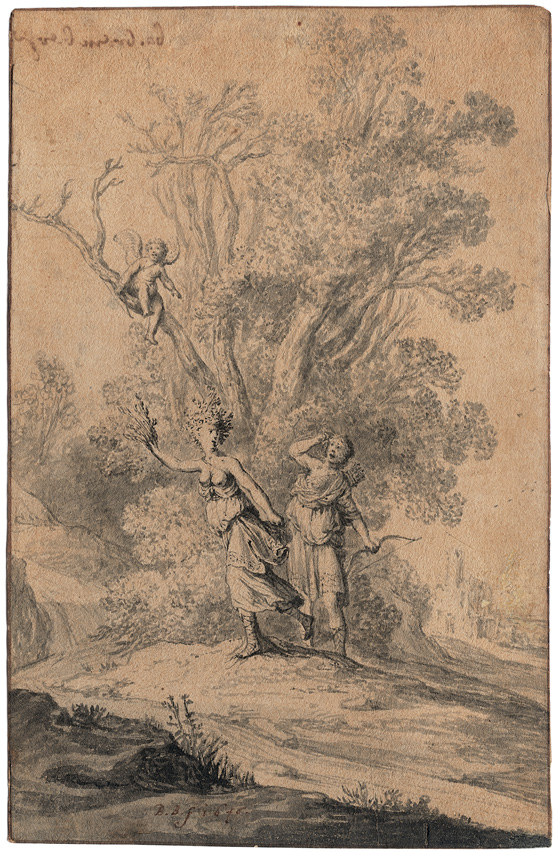Loading the page ...
Bartholomeus Breenbergh
(1598 Deventer – 1657 Amsterdam)
Landscape with Apollo and Daphne. Pen and point of brush and gray ink, borderline in pen and brown ink. 15.4 x 9.9 cm. Monogrammed and dated: B. B. f. 1640.
The draftsman Bartholomeus Breenbergh is known above all for his large Campagna landscapes which he rendered in a loose and beautifully atmospheric style. In 1619 he can be traced for the first time in Rome, where, as one of the founding members of the Bentveughels (the Bird Gang, a group of Dutch artists living in Rome between ca 1617–1720) he lived and worked until 1629. In the following year he returned to his native country and settled in Amsterdam. In Rome Breenbergh was supposedly active in the closer circle of Paul Bril and there are other stylistic affinities in his work to the drawings of Cornelis van Poelenburgh, who, together with Breenbergh, is considered one of the founders of Italianate landscape painting in the Netherlands.
The motifs in Breenbergh’s drawings from his Italian period served as a lifelong source of inspiration for his paintings. The first decade after the artist moved to Amsterdam proved to be especially productive: he became the leading figure of the Italianate school with his large, carefully composed paintings on biblical and mythological themes. After 1640 Breenbergh moved toward a more intimate, poetic approach to landscape in his work and the influence of the light and atmosphere of the southern landscape began to diminish. The present drawing is a characteristic example of the work of this latter period. It seems surprisingly detailed compared to the bold, broad landscape drawings of the Roman years, which, with their stunning contrasts of light and shade are sometimes reminiscent of Claude. Instead, the scene has a unique, poetic intimacy. Breenbergh gives the awful, sometimes glamorous world of the gods a typically Dutch, almost peasant-like framework. The slender, but hardly godlike figures of Apollo and Daphne act in front of a landscape background, with broccoli-shaped trees suggesting those in the work of Esaias van de Velde and Willem Buytewech. The vaguely outlined ruin in the background provides the only faint reference here to the artist’s Italian period. The drawing is probably not a preparatory study for a painting, but as Marcel Roethlisbergers suggests, was more likely an independent work of art. It is in the same spirit as a small painting showing Cimon and Iphigeneia in Berlin. (Gemäldegalerie SMPK; see Marcel Roethlisberger, “New Works by Bartholomeus Breenbergh”, Oud Holland 99, no. 1, p. 57, ill. 10.)
